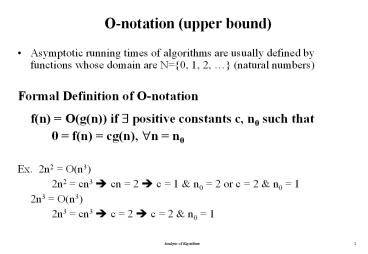O-notation (upper bound) - PowerPoint PPT Presentation
Title:
O-notation (upper bound)
Description:
O-notation (upper bound) Asymptotic running times of algorithms are usually defined by functions whose domain are N={0, 1, 2, } (natural numbers) – PowerPoint PPT presentation
Number of Views:103
Avg rating:3.0/5.0
Title: O-notation (upper bound)
1
O-notation (upper bound)
- Asymptotic running times of algorithms are
usually defined by functions whose domain are
N0, 1, 2, (natural numbers) - Formal Definition of O-notation
- f(n) O(g(n)) if ? positive constants c, n0
such that - 0 f(n) cg(n), ?n n0
- Ex. 2n2 O(n3)
- 2n2 cn3 ? cn 2 ? c 1 n0 2 or c 2
n0 1 - 2n3 O(n3)
- 2n3 cn3 ? c 2 ? c 2 n0 1
2
O-notation (upper bound)
- is funny one-way equality
- O-notation is sloppy, but convenient.
- We must understand what O(n) really means
- O(g(n)) is actually a set of functions.
- O(g(n)) f(n) ? positive constants c, n0
such that - 0 f(n) cg(n), ?n n0
- 2n2 O(n3) means that 2n2 ? O(n3)
3
O-notation (upper bound)
- O-notation is an upper-bound notation
- It makes no sense to say running time of an
algorithm is at least O(n2). - let running time be T(n)
- T(n) O(n2) means
- T(n) h(n) for some h(n) ? O(n2)
- however, this is true for any T(n) since
- h(n) 0 ? O(n2), running time gt 0,
- so stmt tells nothing about running time
4
O-notation (upper bound)
5
?-notation (lower bound)
- Formal Definition of ?-notation
- f(n) ?(g(n)) if ? positive constants c, n0
such that - 0 cg(n) f(n) , ?n n0
- ?(g(n)) f(n) ? positive constants c, n0 such
that - 0 cg(n) f(n) , ?n n0
6
?-notation (lower bound)
7
T-notation (tight bound)
- Formal Definition of T-notation
- f(n) T(g(n)) if ? positive constants c1, c2,
n0 such that - 0 c1g(n) f(n) c2g(n) , ?n n0
- T(g(n)) f(n) ? positive constants c1, c2, n0
such that - 0 c1g(n) f(n) c2g(n) , ?n n0
8
T-notation (tight bound) - Example
9
T-notation (tight bound) - 0 lt c1 h(n) c2
10
T-notation (tight bound) - 0 lt c1 h(n) c2
11
T-notation (tight bound)
- T(g(n)) f(n) ? positive constants c1, c2, n0
such that - 0 c1g(n) f(n) c2g(n) , ?n n0
12
T-notation
13
T-notation
14
Using O-notation for Describing Running Times
- O-notation is used to bound worst-case running
times - bounds running time on arbitrary inputs as well
- O(n2) bound on worst-case running time of
insertion sort also applies to its running time
on every input - What we really mean by running time of insertion
sort is O(n2) - worst-case running time of insertion sort is
O(n2) - or equivalently
- no matter what particular input of size n is
chosen (for each value of) running time on that
set of inputs is O(n2)
15
Using O-notation for Describing Running Times
- O(n) is used to bound the best-case running times
- bounds the running time on arbitrary inputs as
well - e.g., O(n) bound on best-case running time of
insertion sort - running time of insertion sort is O(n)
- running time of an algorithm is O(g(n)) means
- no matter what particular input of size n is
chosen (for any n), running time on that set of
inputs is at least a constant times g(n), for
sufficiently large n - however, it is not contradictory to say
worst-case running time of insertion sort is
O(n2) since there exists an input that causes
algorithm to take O(n2) time
16
Using T-notation for Describing Running Times
- Case 1.
- used to bound worst-case best-case running
times of an algorithm if they are not
asymptotically equal - Case 2.
- used to bound running time of an algorithm if
its worst best case running times are
asymptotically equal
17
Using T-notation for Describing Running Times
- Case (1)
- a T-bound on worst-/best-case running time does
not apply to its running time on arbitrary inputs - e.g., T(n2) bound on worst-case running time of
insertion sort does not imply a T(n2) bound on
running time of insertion sort on every input
since T(n) O(n2) T(n) O(n) for insertion
sort
18
Using T-notation for Describing Running Times
- Case (2)
- implies a T-bound on every input
- e.g., merge sort
- T(n) O(nlgn)
- T(n) O(nlgn)
- ? T(n) T(nlgn)
19
Asymptotic Notation In Equations
20
Asymptotic notation appears on LHS of an equation
21
Other asymptotic notations o-notation (small o)
22
o-notation
23
?-notation (small omega notation)
24
Asymptotic comparison of functions
25
Analogy to the comparison of two real numbers
26
Analogy to the comparison of two real numbers































